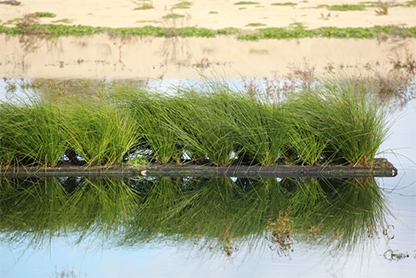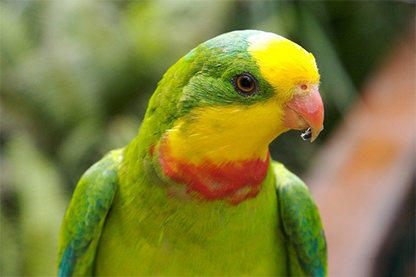Wetlands are important ecosystems that provide a broad variety of habitats within a small area, including aquatic and terrestrial environments in which plants, mammals, amphibians, reptiles, fish and water bugs live.
As the vegetation at the Marrambidya Wetland continues to grow and develop over the years to come, it is hoped this beautiful space will become home to an increasing number of birds, animals and plants.
Flora
There are 3 main types of flora that can be found at the Marrambidya Wetland, terrestrial plants, aquatic plants and weed species. Plants that live in the water help clean the water that enters the wetland by taking up nutrients which they use for growth, and trapping sediment allowing clearer water to discharge into the river.
So effective are wetlands at filtering water, artificial wetlands are used in some areas to help treat storm water in urban environments.
Terrestrial plants are those plant species that grow on land. The dominant plant species at the Marrambidya Wetland is the River Red Gum which is the most common species of Eucalypt along the watercourses around Australia. These great trees are iconic to the Australian landscape and can reach heights of 30 metres tall.
As the River Red Gum ages and limbs fall from the tree over time or if the tree is impacted by disease, hollows in the branches develop. These hollows provide vital habitat for our native animal species including the locally threatened Superb Parrot and Squirrel Glider. Other tenants of these trees in the Marrambidya Wetland include Cockatoos, Galahs and Superb Parrots.
When visiting the Marrambidya Wetland you may spy a few nesting boxes hidden amongst the limbs of the River Red Gums. These nest boxes provide additional homes for the native birds and mammals we want to attract to this site.
Some of the terrestrial plant species you may see at the Marrambidya Wetland:
- River Red Gum (Eucalyptus camaldulensis)
- She-oaks (Allocasuarina)
- Spiney-headed Mat-rush (Lomandra longifolia)
- Spreading Flax-lily (Dianella revoluta)
- Purple Coral Pea (Hardenbergia violacea)
 Aquatic plants are those plant species that grow in water or at the waters edge. Aquatic plants play an important role in maintaining good water quality as they take up any nutrients in the water to use for plant growth. Excessive nutrients in the water may lead to algal blooms. Water plants also provide habitat and food sources for aquatic animals and invertebrates.
Aquatic plants are those plant species that grow in water or at the waters edge. Aquatic plants play an important role in maintaining good water quality as they take up any nutrients in the water to use for plant growth. Excessive nutrients in the water may lead to algal blooms. Water plants also provide habitat and food sources for aquatic animals and invertebrates.
As you wander the site you may spot some floating reed beds in ponds 2 and 3. The reed beds are designed to allow the plant roots to grow deep in to the water to physically filter and remove algae-causing nutrients such as nitrogen and phosphorous.
Some of the aquatic plant species you may see at the Marrambidya Wetland:
- Knob Sedge (Carex inversa)
- Rush (Juncus subsecundus)
- Common Reed (Phragmites australis)
Unfortunately some unwanted weeds also call the Marrambidya Wetland home. Weed management was an important aspect of the conversion of the site from sewage treatment ponds to the wetland.
Ongoing maintenance and involvement from groups such as the Wagga Wagga Urban Landcare Group will help minimise the impact of weeds on the Wetland. Residents and visitors can minimise the spread of weeds by:
- Regularly removing weeds species from their gardens
- Planting local native species in your garden
- Volunteering with your local Landcare group
- Checking your vehicle, caravan or 4WD for hitchhiking weeds when leaving camping and recreation areas
Fauna
 The Marrambidya Wetland will attract migratory birds, as well as be home to year round residents. Visitors to the wetland can spend time in the bird hides and watch the birds in their natural setting with minimal disturbance.
The Marrambidya Wetland will attract migratory birds, as well as be home to year round residents. Visitors to the wetland can spend time in the bird hides and watch the birds in their natural setting with minimal disturbance.
Birds that you may see at the Marrambidya Wetland include the:
- Australian Wood Duck
- White-faced Heron
- White-necked Heron
- Sulphur-crested Cockatoo
- Galah
- Masked Lapwing
- Barking Owl
- Tawny Frogmouth
- Superb Parrot (locally threatened)
After dark, the Marrambidya Wetland comes to life in the wonderful world of nocturnal mammals.
Hollows provide important shelter for animals including Brushtail Possums, Ringtail Possums and the locally threatened Squirrel Glider. As limbs fall from the River Red gums they sometimes allow hollows to form. These hollows provide perfect protection for mammals and birds.
Since European settlement we have changed the landscape significantly, losing large amounts of natural vegetation and the important habitat that this provides for native animals. Constructed nesting boxes have been installed at the wetlands to provide extra housing for the animals we want to visit the site.
Regular monitoring of the nestboxes is carried out by volunteers and Council staff. Guided spotlighting tours take place each September to celebrate Biodiversity Month. Keep an eye on the 'Events' page for upcoming tours.
Water Bugs
Water bugs (macro-invertebrates) that live in wetlands can be quite different to those living in rivers and creeks. This is due to the differences in water movement where the wetland is much calmer than the consistent flow of a creek or river. Macro-invertebrates can be quite sensitive to their environment and the presence of some sensitive species indicate good water health. The Water Bug Identification Sheet can help you identify water bugs you may find at the Marrambidya Wetland and also give an indication of their sensitivity to poor water quality.
Fish
Fingerlings have been released into the ponds at the Marrambidya Wetland to establish a healthy fish population. Approximately 20,000 Murray River Rainbow Fish, Native Gudgeon, Freshwater Shrimps and Yabbies were released into the wetland in June 2016.
Frogs
Wetlands provide perfect habitat for tadpoles and frogs with the presence of both wet and dry environments. The still waters of the ponds and the water plants provide shelter for the tadpoles to grow big and develop into fully grown frogs. Frogs are sometimes very hard to see so we rely heavily on identifying their calls to determine which species are residing at the Marrambidya Wetland.
Frogs of the Marrambidya Wetland include:
- Giant Banjo Frog
- Barking Marsh Frog
- Common Eastern Froglet
- Plains Froglet
- Peron's Tree Frog
As the wetland becomes more established and the vegetation grows it is hoped the endangered Southern Bell Frog will find safe refuge in this new reserve.
Turtles
Perhaps one of the cutest residents of the Marrumbidya Wetland would be the turtle. These cool creatures can be seen sunning themselves on the various snags located within the ponds. When visiting the Marrambidya Wetland look out for the Eastern Long-necked Turtle and the Murray Turtle.
